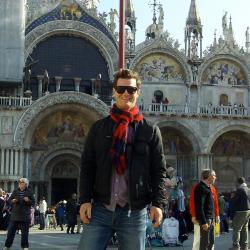In the wake of several live venues closing down in the past few years, news of Gamli Gaukurinn not only staying open, but working on improving its stage, lights and sound system was music to our ears (pardon the pun). To finance these changes, the organisers put together a four-day music festival. Below you can find our full account of the festival.
Wednesday: The (Anything But) Acoustic Night
Words by Jonathan Pattishall
Whoever decided to bill this as an “acoustic pop” showcase was a bit confused about the meaning of the word “acoustic.” Almost every band that performed at Gamli Gaukurinn on Wednesday night deployed at least one juiced guitar, bass or synthesiser. Some acts (*cough Pétur Ben cough*) had more electric music-making implements on stage than actual musicians. The only thing really “acoustic” about the evening, in fact, was the hollowed-out quality of the sound waves as they floated over an almost entirely empty dance floor—sadly, there weren’t many people there.
Things got off to a depressing start with back-to-back sets by Myrra Rós and Soffía Björg. The singer-songwriters weren’t depressing because they played poorly—both women have beautiful, almost haunting voices, and their backing bands performed admirably as well—but because the music simply seems like a soundtrack for jumping off bridges. “All of your dreams / Torn at the seams,” Myrra sang in one typical couplet, cradling her guitar like a mother might a stillborn baby.
After a pleasant few songs from Hymnalaya, the concert’s first real highlight took the stage. Kaleo’s carefully crafted blend of bluesy rock didn’t lose any of its appeal, despite swapping out a normally electric guitar with an acoustic one and trading a drum kit for what looked like a djembe. The band opened with “Broken Bones,” one of the best—and also probably most underplayed—songs from their debut album. The downbeat sharecropper boogie was a perfect choice for an opener: though the crowd was still sparse, some people at least shuffled their way out to the dance floor.
Pétur Ben, the second highlight of the night, was also the last highlight of the night, as he was the last act to perform. Sometimes Pétur plays solo sets, just a man and his guitar; sometimes he plays with a full backing band; on this evening in Gamli Gaukurinn, he decided to split the difference and play along with a computerised bass and drum set.
One of the great ironies of the modern world is that digital technology, invented partially to help remove the element of human error from our daily lives, often just creates new avenues for that same error to hit us upside our heads like a ton of unexpected bricks. Such was Pétur’s misfortune when, at the beginning of one song, his drum track didn’t line up with his live guitar strumming. It was only a minor blemish, though—the rest of his set was an all-encompassing ambient experience that twisted the supposedly “acoustic” theme of the night into soulful electronic contortions.
- Gamli Gaukurinn Renewal Festival, Wednesday, April 9: Soffia Björg
- Gamli Gaukurinn Renewal Festival, Wednesday, April 9: Myrra Rós
- Gamli Gaukurinn Renewal Festival, Wednesday, April 9: Hymnalaya
- Gamli Gaukurinn Renewal Festival, Wednesday, April 9: Kaleo
- Gamli Gaukurinn Renewal Festival, Wednesday, April 9: Pétur Ben
Thursday: 99 Problems, But A Venue Ain’t One
Words by: Fred Q. Labelle
For the second evening, five hip-hop acts stormed the iconic venue, usually associated with rock and roll. The Icelandic hip-hop on display was far removed from gangsta rap, something that would have alienated those that don’t like their rap riddled with misogyny.
The one-man act Lamako had the daunting task of opening the show and he did so brilliantly. Stepping on stage, nervously at first, he masterfully turned himself into a human beatbox, delivering heavy bass lines, crunching distortion and synthesiser beats with nothing but his mouth, throat and nostrils. The short but enjoyable improvised show then gave way to MC Bjór & Bland urban rhymes, saxophone solos and hilarious stories about bad cooking and throwing up. Bland’s groovy sound actually ended up stealing the show, with the instrumental segments being more than just a basis for Bjór’s entertaining flow.
The renowned Icelandic artist Cesar A took us back to the ’90s with his beats, moves and outrageous outfit. Urging the audience to participate in choruses, putting their hands in the air, and waving them like they just don’t care, the show felt like a blast from the past. Cryptochrome then took us into deep hip-hop waters, with Una Stígsdóttir and Anik Karensson unleashing intense rhymes (in English, too) to minimalistic beats. Una’s haunting choruses were contrasted with Anik’s raging verses, and their set was clever, well-crafted, and demonstrated hip-hop at its best.
Reykjavíkurdætur, who had been happily dancing away to the other acts, stepped up in groups of two or three to perform a selection of songs, collectively dropping some feminist bombs. For example, sisters Anna Tara and Helga Katrín Andrésdóttir rapped about how straight boys should let their girlfriends finger their bums before they fucked theirs, promoting equality inside and outside of the bedroom. The 11 present members then took centre stage and sung their anthem “Reykjavíkurdætur,” and new song “Fiesta,” about politics, the patriarchy and taking back the night, some of them donning colourful outfits that played up their message of political equality. Respect.
Friday: Mayhem And Fun Times All Around
Words by: Tómas Gabríel Benjamin
The third day of Gamli Gaukurinn’s renewal festival featured some of Iceland’s more notable rock and metal bands, but it was appropriately named hardcore band Muck that started the show, and they did so with style. An extra singer stood on the other side of the barricade and commended chanting Tibetan monk-style to the band’s instrumental opening. Muck then played a smashing set characterised by some of the cleanest dirty sounds imaginable. Guitarist Indriði (left on picture), however, made the fatal mistake of wearing his own band’s t-shirt.
Endless Dark are a hardcore band that takes the aesthetic up to 11; band members generally run around the stage wearing basketball Ts, beating on their chests like gorillas, and mashing together melodic verse with guttural howling. On this night, however, the seven-piece band hardly had any space to move, and looked visibly distraught not being able to bounce around. They tried to start a mosh pit, but were unsuccessful.
Progressive metalcore band Wistaria’s ambient intro was so powerful that my eye sockets trembled, and my beer almost slipped off its table. If they could channel that heaviness into one spot, they could make a killing as chiropractors, or weapons of mass destruction. Their final two songs featured two extra singers to the four-man band, and it was a brilliant success, leading to the festival’s very first pit.
Darknote stepped up and played guitar ladders like they were nobody’s business. Their set was solid, with a few good guitar shreds, but it unfortunately paled in comparison to Angist’s show. The female-led death metal band had an incredibly tight and heavy sound, complemented by Edda’s wonderful death growls which were at once powerful as well as expressive. But even as a native Icelandic speaker and a metal head, the lyrics were often completely unintelligible. Half way through the set, the instruments started bleeding into one another, but the sound was still clear enough to be enjoyable. Drummer Tumi really stood out, thrashing away at the drums – come morning, I imagine his arms had turned into putty.
By the time the oldies of Bootlegs had finished setting up, it was clear that the show was already over. They played a few original and cover songs, but everyone had packed up and it was time to head out.
Saturday: Going Out With A Headbang
Words by: Jonathan Pattishall
Rock, in at least four of its dozens of distinct variations, was the centre of attention on Saturday night. Johnny And The Rest brought the smooth blues rock, kimono the freak indie, Kvika the ’90s throwback, and Brain Police the skull-crushing desert blast. The crowd was sizeable, the atmosphere lively and the starting—and ending—times appropriately late. Let’s hope the venue was able to translate this kind of quality show into a successful fundraising effort. That was, after all, the whole point.
Kimono’s unique stage presence and sound provided some of the night’s more remarkable moments. The band toggled between rocking, grooving and droning, somewhere in the sonic interstices of Little Feet and Fugazi. They certainly kept the crowd engaged, but also occasionally ventured over into a boneyard of pretence. The back-and-forth between the musicians and various members of the crowd at the start of their set was probably well-intentioned, but the natural disparity between artist and audience made the whole thing come off as high-handed. I would never be caught dead yelling at a musician to shut up and play, but the temptation was certainly there before kimono struck their first chord.
As the biggest act of the night, Brain Police was wisely saved for last. The band’s set list was sadly more or less identical with the one they blazed through at Dillon a week prior (read more about that here), and their energy was perhaps a tick or two lower than the Dillon show, but the renowned sound system at Gamli Gaukurinn also ensured that the tonal quality would be that much higher. Every riff and hook and wailed stanza was crystal clear. As singer Jens Ólafsson punched his way into the refrain of “Beefheart,” the crowd set its energy against the band’s. Though there was a noted absence of anything resembling a mosh pit that night, heads still appeared as Slinky’s on shoulders, wobbling and thrashing around like there was no tomorrow.
Unfortunately for this headbanger, tomorrow brought with it a world of neck pain. That, and the satisfaction of knowing that Gamli Gaukurinn sees upgrades in its future, as opposed to closure.
- Gamli Gaukurinn Renewal Festival, Saturday, April 12: Johnny And The Rest
- Gamli Gaukurinn Renewal Festival, Saturday, April 12: Johnny And The Rest
- Gamli Gaukurinn Renewal Festival, Saturday, April 12: Kvita
- Gamli Gaukurinn Renewal Festival, Saturday, April 12: kimono
- Kimono playing at Gamli Gaukurinn Renewal Festival at Gaukurinn in 2014
- Gamli Gaukurinn Renewal Festival, Saturday, April 12: Brain Police
- Gamli Gaukurinn Renewal Festival, Saturday, April 12: Brain Police
- Gamli Gaukurinn Renewal Festival, Saturday, April 12: Brain Police
Buy subscriptions, t-shirts and more from our shop right here!











































